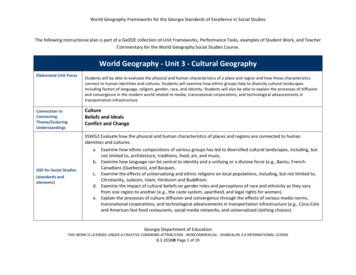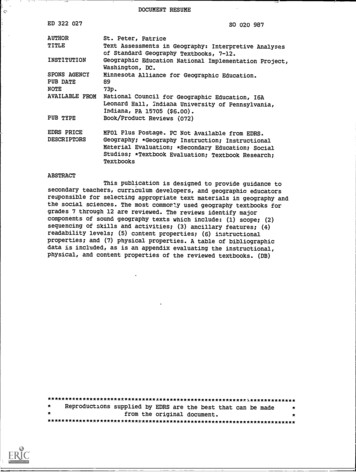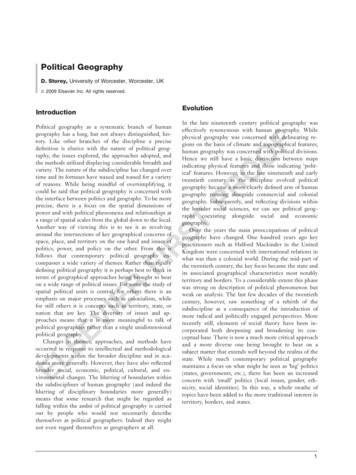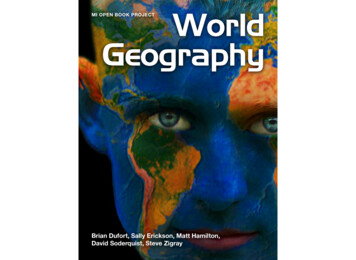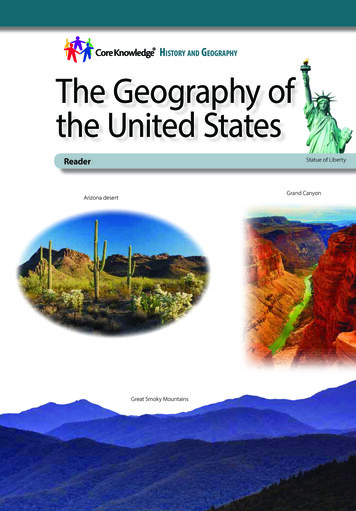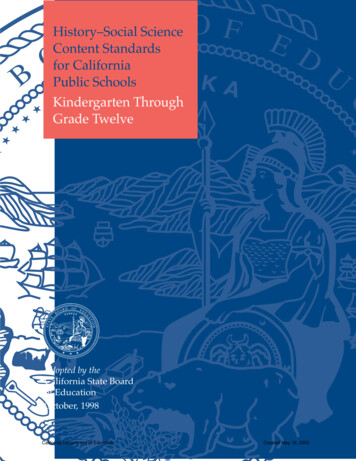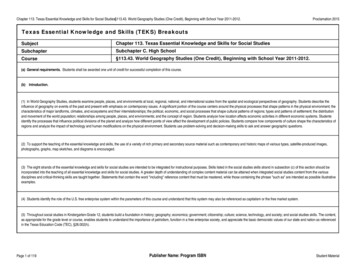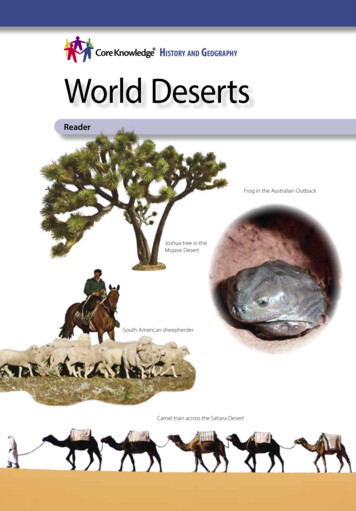
Transcription
History and GeographyWorld DesertsReaderFrog in the Australian OutbackJoshua tree in theMojave DesertSouth American sheepherderCamel train across the Sahara Desert
THIS BOOK IS THE PROPERTY OF:STATEBook No.PROVINCEEnter informationin spacesto the left asinstructed.COUNTYPARISHSCHOOL DISTRICTOTHERISSUED TOYearUsedCONDITIONISSUEDRETURNEDPUPILS to whom this textbook is issued must not write on any page or markany part of it in any way, consumable textbooks excepted.1. T eachers should see that the pupil’s name is clearly written in ink in thespaces above in every book issued.2. The following terms should be used in recording the condition of thebook:New; Good; Fair; Poor; Bad.
World DesertsReader
Creative Commons LicensingThis work is licensed under aCreative Commons Attribution-NonCommercial-ShareAlike4.0 International License.You are free:to Share—to copy, distribute, and transmit the workto Remix—to adapt the workUnder the following conditions:Attribution—You must attribute the work in thefollowing manner:This work is based on an original work of the CoreKnowledge Foundation (www.coreknowledge.org) madeavailable through licensing under a Creative CommonsAttribution-NonCommercial-ShareAlike 4.0 InternationalLicense. This does not in any way imply that the CoreKnowledge Foundation endorses this work.Noncommercial—You may not use this work forcommercial purposes.Share Alike—If you alter, transform, or build upon this work,you may distribute the resulting work only under the same orsimilar license to this one.With the understanding that:For any reuse or distribution, you must make clear toothers the license terms of this work. The best way todo this is with a link to this web /4.0/All Rights Reserved.Core Knowledge , Core Knowledge Curriculum Series ,Core Knowledge History and Geography and CKHG are trademarks of the Core Knowledge Foundation.Trademarks and trade names are shown in this bookstrictly for illustrative and educational purposes and arethe property of their respective owners. References hereinshould not be regarded as affecting the validity of saidtrademarks and trade names.ISBN: 978-1-68380-317-1Copyright 2018 Core Knowledge Foundationwww.coreknowledge.org
World DesertsTable of ContentsChapter 1What Is a Desert?. . . . . . . . . . . . . . . . . . . . . . . . . . . . . . . . . 2Chapter 2Deserts of Africa . . . . . . . . . . . . . . . . . . . . . . . . . . . . . . . . . 12Chapter 3Australia, a Dry Continent . . . . . . . . . . . . . . . . . . . . . 18Chapter 4Deserts of Asia . . . . . . . . . . . . . . . . . . . . . . . . . . . . . . . . . . . 24Chapter 5Deserts of North America . . . . . . . . . . . . . . . . . . . . . . 30Chapter 6Deserts of South America . . . . . . . . . . . . . . . . . . . . . . 36Glossary. . . . . . . . . . . . . . . . . . . . . . . . . . . . . . . . . . . . . . . . . . . . . . . . . . . . . . . 44
World DesertsReaderCore Knowledge History and Geography
Chapter 1What Is a Desert?Desert Landscapes When you hear theThe Big Questionword desert, do you think of a hot, dryplace where nothing grows and everything What featuresdetermine whether anis covered by sand? Some deserts fit thisarea of land is a desert?description, but you might be surprisedto learn that notVocabularyall deserts are sandy or completelypolar, adj. relating tobarren or even hot. For example, therea geographic pole orare polar deserts in the Arctic and in thethe area around itAntarctic region.2
The Sahara is the largest nonpolar desert in the world.3
Most climatologists define the word desert as a place where evaporationexceeds precipitation. One feature of a desert can be its dryness, or aridity.One way of assessing the dryness of a place is by measuring how manyinches of precipitation it gets in an average year.Most deserts get less than ten inches ofprecipitation a year—this is also true of the Arcticand the Antarctic region. Compare that meagerten inches with the average yearly precipitation insome major American cities:CityAverage Yearly PrecipitationNew Orleans61 inchesNew York City42 inchesChicago35 inchesDallas29 inchesSan Francisco20 inchesLos Angeles15 inchesVocabularyclimatologist, n.a scientist whostudies weatherpatterns over timeevaporation, n. theprocess by which aliquid changes toa vapor or gasprecipitation, n.water falling toEarth’s surface asrain, hail, snow,or sleetThe two largest deserts on Earth are the Antarctic Polar Desert and the Arctic Polar Desert.This image shows an area of the Antarctic Polar Desert.4
Even when it does rain in a desert, plants and animals are often only able touse a small amount of the rainwater. For example, sudden thunderstormscan cause heavy rainfall, but the water quickly runs off in flash floods anddoes not soak into the ground. When a light shower falls over a dry desertarea, most of the rain evaporates before it touches the ground because theair is so dry.The strength of the sun is also a factor. When temperatures are very high,as they are in many deserts, evaporation speeds up. Because of this, the waterhas less time to soak into the parched soil.Desert TemperaturesMany deserts are hot as well as dry. Not surprisingly, deserts near the equatorare very hot. In the Sahara in Africa, daytime temperatures routinely soarwell above 100 Fahrenheit (F). However, the highest recognized recordedtemperature was measured on July 10, 1913, at Greenland Ranch in DeathValley, California. On that day, the temperature reached 134 F.Deserts far from the equator tend not to have the scorching hot temperaturesof the Sahara. In fact, during the winter, these deserts can be freezing cold.The average winter temperature in the Gobi in northern China is 10 to l5 F.And then there are the polar deserts. In the Arctic Polar Desert, the wintertemperature can drop below -60 F.One feature that both “hot” and “cold” deserts share is a dramatic changebetween daytime and nighttime temperatures. At night, the temperature ina hot desert can drop anywhere from 30 to 70 F. Clouds keep warm air nearthe ground. Desert skies, whether they are hot or dry, are often cloudless, soat night much of the heat rises into the sky, leaving the desert much colderthan it is in the daytime.5
6WSNEPACIFIC OCEANChihuahuanDesertSonoranDesertMojaveArctic tagoniaSOUTHAMERICACaribbean SeaNORTHAMERICADeath ValleyARCTIC OCEANMajor Deserts of the WorldASIAGobiDesertAntarctic DesertINDIAN OCEANRed PEArctic Desert0The Outback2,000 milesAUSTRALIAPACIFIC OCEAN
Desert LandformsSome deserts contain great seas ofsand, but other deserts have littleor no sand. Only about 2 percent ofNorth American deserts are coveredwith sand. The Sahara, famous for itssand dunes, is only about 10 percentsand covered.Just as deserts can exhibit a widerange of temperatures, they canalso contain many different typesof landforms. Deserts can havemountains, plateaus, or plains.Some are covered with gravel, barebedrock, or sand.Great Sand Dunes National Park, in southernColorado, is known for its spectacular dunes.Sometimes the desert landscape isscarred and crisscrossed with ravines,gullies, and canyons caused by rushingwater from flash floods. On thoserare occasions when rain does fall,the water runs downhill, carving a paththrough the thin soil. Eventually thepath turns into a ditch, the ditch intoa gully, the gully into a ravine, and theravine can even turn into a canyon.Desert winds also shape thelandscape. The wind blowsaway whatever thin topsoil there is,leaving behind sand, rock, or gravel.Here you can see how over many, manyyears, water has worn away the landscapeto create a ravine.7
Life in the DesertAlthough some deserts of the world can be difficult places to live, overthousands of years groups of people, as well as animals and plants, have foundways to survive. The key to survival is the ability to adapt to the environment.The giant saguaro (/suh*war*oh/) cactus grows in the deserts of southernArizona and northern Mexico. To survive in the desert, the cactus hasadapted to the environment in several ways. Its stem is fleshy and thick,allowing it to store enormous amounts of water. It has no leaves that couldlose moisture. It also spreads its roots in a wide area near the surface of thesoil. This enables it to absorb, or take in, as much water as possible duringthe infrequent rains.Camels live in the Sahara and in other deserts. They can go for long periods of timewithout drinking. The North American kangaroo rat is even more ideally adaptedto desert life. It can survive its entire lifetime without sipping a drop of water.Kangaroo rats get the water they need to survive by eating plants, such as cacti.8
The giant saguaro cactus has adapted to life in the desert.9
It gets moisture from seeds and plant leaves, which contain small amounts ofwater. However, its main adaptation is the special water recycling system inits own body.The kangaroo rat’s kidneys recycle water internally. The animal loses verylittle water through natural processes. When a kangaroo rat has to relieveitself, it leaves behind a patch of crystals instead of a stream of liquid urine.Many desert animals, including rats, mice, squirrels, and lizards, are nocturnal.They avoid the harsh heat of the daytime by burrowing deep into the groundand coming out only at night.People have also learned how to survive in desert areas. For example,some native peoples of the American Southwest learned how to use irrigationsystems to water their crops. Entire Native American societies lived inAmerican desert lands. This is also true of the history of groups of peoplewho live, or once lived, in the great deserts of Africa and Asia.Today, there are large cities in desert areas of the United States and acrossthe globe. Lots of people have their homes in deserts. New technologiesinvolving irrigation for crops, and dams for storing water, as well as accessto deep wells underground, have made life insuch environments perfectly possible. Areas ofdesert have quite literally been transformed intopopulated city centers.Growing DesertsAlthough desert areas may be shrinking in someparts of the world, they are growing in others. Inparts of Africa, desertification is a major problem.African farmers in need of farmland have clearedand planted on semiarid lands near the edges ofthe Sahara. When farm animals nibble away theplants in these areas and farmers use the scattered10Vocabularydesertification, n.natural or humanprocesses thatturn fertile land intoa desertsemiarid, adj.describinglocations withlittle precipitation,but with enoughmoisture to supportthe growth ofgrasses, shrubs, anda few scattered trees
Las Vegas is a thriving, bustling city in Nevada’s Mojave Desert. The average annual rainfallthere is 9.63 inches.brush for fuel, there is little or nothing left to hold back the winds. Oftenthese winds blow away the thin topsoil and blow in desert sand.Today, about 20 percent of the world is desert. Changes in weather patterns,together with changes in the ways people treat the land, will determinewhether that number shrinks, grows, or stays the same.11
Chapter 2Deserts of AfricaThe Sahara A caravan of camels makesits way across endless sand dunes. Itfollows a route between shifting dunesthat sometimes rise several hundred feethigh. The camels labor along at a steadytwo miles per hour. They each carrynearly four hundred pounds of salt fromthe salt mines in the desert.12The Big QuestionWhat are thesimilarities anddifferences betweenthe Sahara andKalahari deserts?
A camel train crosses the sand dunes of the Sahara.13
The heat is brutal. The sun is high overhead, and the sand is reflecting itsheat. Fortunately, camels are designed for this kind of heat. Their long legskeep their bodies well above the burning sand, their stomachs hold a lot ofwater, and their humps contain fat that can be used for energy when foodsupplies are short. But the humps have begun to sag, a sign the camels havegone too long without food.The caravan leaders are not worried. They know that just over the horizonis an oasis, where they and their animals can rest in the shade and replenishtheir food and water supplies. The camels can each drink as much astwenty-five gallons of water, and their humps will firm up when they grazeat the oasis. The food and water they take in at the oasis will be enough tolast for about a week.For thousands of years, camel caravans have carriedgoods across the Sahara. Even today, camelcaravans go to remote places in the Sahara thattrucks cannot reach.Oasis in the Sahara14Vocabularyoasis, n. an area inthe desert wherethere are plantsand water
The Sahara is a patchwork desert of rockymountains, salt flats, gravel plains, and sandseas. It stretches about three thousand milesacross Africa, from the Atlantic Ocean in thewest to the Red Sea in the east. It is 1,200 milesfrom north to south and covers three and a halfmillion square miles. That’s almost the size ofthe United States.Daytime temperatures in the summer areextremely hot. But like most deserts, theSahara does not hold the daytime heat.Nighttime temperatures can sometimes dropFennec foxto freezing during the cooler months of the year.The Sahara is drier than most deserts, with an average rainfall of less thanfour inches per year. There are many years in which no rain falls in someparts of the desert. Nevertheless, the Sahara does have widely scatteredpermanent water sources, such as oases. And the world’s longest river, theNile, runs through the eastern part of this largest-of-all deserts.Despite its barren features, much of the Sahara supports a variety of plantand animal life. Many plants have special root systems that reach deep intothe earth to find water. Both large and smallanimals live in the Sahara. There are antelopes thatrarely drink water but that get their moisture fromthe shrubs they eat. Gazelles and wild mountainsheep roam the dusty Sahara. The small fennecfox, whose large ears radiate heat from its body tohelp keep it cool, also calls the Sahara its home.Vocabularysalt flat, n. anarea of land whereevaporation has lefta layer of saltradiate, v. to send outThe Sahara supports human life too. Although fewer people live in the drierareas of the Sahara, millions and millions of people live on the desert margins.15
Some parts of the Kalahari can support a large variety of wildlife. Here you can seelionesses resting during the heat of the day.A number of African countries have land that extends into this vast desert,including Algeria, Chad, Egypt, Libya, Mali, Mauritania, Morocco, Niger,Sudan, and Tunisia.The Kalahari DesertFar to the south of the Sahara, on the other sideof the equator, lionesses rest near a watering hole.The animals are in a game reserve in the centerof the Kalahari Desert. Unlike the scorched earthof the Sahara, the Kalahari has a rich assortment ofplants and wildlife. Because of this, it is sometimesreferred to as a “thirstland” rather than as a desert.The Kalahari is a large basin in the central part ofsouthern Africa. It covers an area almost as large asthe state of Texas. As in other deserts, rain is scarce16Vocabularygame reserve, n.an area set asideby the governmentwhere animals areprotected fromhuntersbasin, n. an area ofland that is lowerthan the landaround it
here and does not fall in predictable patterns. Most of the Kalahari averagesabout five inches of rain per year. Yet some parts get more than fifteeninches. This is usually enough moisture to support a variety of wildlife—largeanimals such as wildebeests, lions, antelopes, jackals, elephants, giraffes, andzebras, as well as many small animals, birds, and reptiles. Over thousandsof years, one group of people called the San (or Bushmen) learned to adaptremarkably well to the dry conditions of the Kalahari.The San PeopleThe San learned how to find and save water. They use ostrich eggs as storagecontainers. Ostrich eggs are the largest eggs laid by any bird. One ostrich eggcan hold as much liquid as two dozen chicken eggs. The San make a hole ateach end of an ostrich egg. Then they blow out the insides, which they usefor food. After a rain, they fill the hollow eggshells with water and tightly plugthe two ends. Then they bury the filled shells in the sand along their routes.When the droughts come, as they always do, the San have a water supply.The San, or Bushmen, are experts when it comes to living in the desert. Here you can seean ostrich egg being used to store water during a trek.17
Chapter 3Australia, a Dry ContinentSurviving in the Desert In the heartThe Big Questionof Australia, a man walks across theWhat strategies havereddish-orange earth dotted withAboriginal peoplesscrub brush. The man is an Aboriginaladopted in order toperson. Aboriginal peoples havesurvive the harshlived on the Australian continent forconditions of desert life?at least fortyVocabularythousand years. Thousands of years ofclose and careful observation of theirscrub brush, n.small or short bushesenvironment have equipped Aboriginaland treespeoples for survival on this mostly flat,mostly desert land.The man stops to look at the earth. To the untrained eye, this spot is no differentfrom any other spot on the ground. He stomps with his bare foot, raising littleclouds of red dust. Lizards scurry into the scrub brush.The man stops stomping and listens. He hears what he hoped to hear—thecroaking of frogs, muffled beneath the earth. The frogs have been tricked. Fromtheir burrows under the surface, the desert frogs thought they were hearing thesound of thunder, signaling that rain would soon fall.18
The desert sands of central Australia support an unusually large number ofanimals, including lizards, frogs, and rodents. These animals have learnedhow to survive there. Some desert frogs, for example, can store water intheir bladders for long periods of time.19
In a real rainstorm, the frogs emerge from their burrows and drink water fromrain pools. They fill their bodies almost to bursting. Then they retreat to theirburrows and use the water stored in their bodies until the next storm.But the man has fooled the frogs. He uses sticks to dig in the earth. Finding aburrow, he pulls out a frog, its body bloated with water. Tilting his head back,he squeezes the frog until a stream of liquid squirts out, flowing down theman’s parched throat.The OutbackTwo-thirds of Australia is arid or semiarid, withfew rivers and little rain. The interior of thecontinent—called the Outback—is mostly desert.The Outback is so dry in some regions that it seemsimpossible that any creature could survive there.Most of the desert land is covered with sandhills and spotted with short grasses. Sands oftenswirl into huge dunes. There is not much waterin the Outback, but after a rain, rocky poolssometimes fill up. These pools are importantsources of water. Water also collects in pools in oldVocabularyinterior, n. anarea far from thecoast in a countryor continentriverbed, n. theground at thebottom of a rivermarsupial, n. a typeof mammal thatcarries its young ina pouchriverbeds, places the Australians call billabongs(dry streambeds that fill with water only in the rainy season). Sudden, heavyrains can briefly fill old riverbeds and lakes, but the water quickly washesdown the riverbed, and the lakes dry out, leaving salt flats.This dry land supports many animals not found anywhere else. One such animalis the emu, a large flightless bird that can weigh as much as one hundred pounds.Another such animal is the kangaroo. Kangaroos are marsupials. Marsupials arewell adapted to the desert conditions, mainly because they require less food thanmost other mammals. Kangaroos can survive on less food because it takes lessenergy to hop on their two hind legs than it takes to run on four legs.20
An emu and its young search for food in the Outback.The malu, or red kangaroo, is found in the deserts of Australia.21
A Singing MapToday, only a fewAboriginal people wholive in the Australianinterior continue thetraditional way of life.However, before theEuropeans came toAustralia and disruptedtheir culture, theAboriginal people provedthat human beings cansurvive in even the mostunforgiving climate.According to the myths ofthe Aboriginal people, theworld was created duringthe “dreamtime,” a timeThis is an Australian gum, or eucalyptus, tree.before time. The thingsof Earth were created by ancestral beings. These beings walked Earth singingout the name of each thing as they created it. They sang about the waterholes, the gum trees, the riverbeds, the sand dunes. Everywhere they walked,they sang, leaving a trail of song behind them. Once the world was createdand named, the beings disappeared into nature. The beings themselvesdisappeared, but their songs survived. This is the Aboriginal peoples’ myth ofhow their “songlines” came into being.These songlines, or songs, have been passed by word of mouth fromgeneration to generation for thousands of years. The songlines are literallymaps of the land.22
Australia’s Aboriginal people were originallynomadic hunters and gatherers. These smallgroups of people wandered a territory that couldbe as large as a thousand square miles. By singingthe songs, they could find the food and waternecessary for survival. Their songlines led themVocabularynomadic, adj.moving aroundoften in search offood; not settled inone placeto rocky pools of water a hundred miles away, toplaces where they could find wildplant foods in season, or to richhunting grounds.A single Aboriginal man ona “walkabout,” or wanderingjourney, might reach the edgeof the territory described in hissonglines. He would then ask thegroup of Aboriginal people in thenext territory to teach him theirsonglines. He could then safelytravel long distances in the harshdesert, using the musical map ofthe songlines to find his way.The songlines continue to provideAboriginal people with theknowledge they need to survive intheir desert lands.Australia has been home to the Aboriginalpeople for thousands of years. BeautifulAboriginal rock art has been foundthroughout Australia.23
Chapter 4Deserts of AsiaThe Gobi One of the largest deserts inAsia, the Gobi, covers a great part ofMongolia and a part of northern China.Eighty million years ago, on what is nowthe vast, bone-dry region of the Gobi,a fight to the death took place.24The Big QuestionHow would youcompare theGobi Desert tothe deserts of theArabian Peninsula?
The Gobi in central Asia is one of the world’s highest, driest deserts.25
When Dinosaurs Walked the EarthA protoceratops, a plant-eating dinosaur,peacefully grazed near the banks of a salt marsh.In the grasses covering the area, a predator lurked.It was a velociraptor, a small, but powerful, meateating dinosaur. Sensing that the moment wasright, the velociraptor struck. Using its strong hindVocabularysalt marsh, n. anarea of coastalwetland, directlyaffected by the riseand fall of the tidelegs, it jumped on the back of the protoceratops.The plant-eating dinosaur fought back, using its hind legs, its long heavy tail,and its beak-shaped jaws. But neither animal could overcome the other. Soonboth lay on the ground, gasping their last breaths. They died there together,predator and prey. Nearly eighty million years later, scientists discovered theirbones in what had become the arid desert of the Gobi.The Gobi Desert has been described as a treasure trove of dinosaur bones. Here you cansee dinosaur bones found in the Gobi Desert.26
Forbidding LandscapeMountains almost completely surround the Gobi, blocking the path of rain clouds.Most of the Gobi’s land is covered in rock and gravel, with few sand dunes.The Gobi receives less than eight inches of rainfall per year on average. Insome places, it receives less than four inches. There are rivers that come intothe Gobi out of the mountains that ring the desert, but they dry up beforereaching the interior.The dryness and salty soil limit the growth of vegetation to scrub brush andgrasses. Near a rare river, or where groundwater creates an oasis, poplar trees,flowering shrubs, and reeds grow.Temperatures are extreme in the Gobi. In the winter, it can get as coldas -40 F. In the summer, temperatures can rise to more than 100 F.Extreme dryness and extreme temperatures make the Gobi one of themost forbidding of Earth’s deserts.Nomadic people of Mongolia live in the Gobi Desert.27
The Arabian PeninsulaThe Arabian Peninsula lies between the Red Sea and the Persian Gulf. Itsnorthernmost end connects the continents of Africa and Asia. The ArabianPeninsula is made up of the countries of Yemen, Oman, Qatar, Bahrain,Kuwait, Saudi Arabia, the United Arab Emirates, and parts of Jordan and Iraq.Parts of the peninsula are covered with rock andgravel, but most of it is a vast expanse of sand. It isVocabularythe largest sand desert in the world. Sand dunes canpeninsula, n. a pieceof land sticking outinto a body of water,so that it is almostsurrounded by waterreach as high as eight hundred feet and stretch forthirty miles. The land is mostly empty. One large partof the peninsula is called Rub’ al Khali, meaning EmptyQuarter in Arabic. The few camel-herding Bedouintribes that roam this land call the region ar-Ramlah,or the Sand. In the summer, the average daytimetemperature in the sand deserts can reach 110 F.Bedouin, adj.relating to nomadicArab tribes of Arabiaand North AfricaThe sand dunes of the Arabian Peninsula can be hundreds of feet high and manymiles long.28
Not a single significant permanent river runsthrough this peninsula. Most of the land is bonedry. Where there is enough moisture for peopleto live, the most important plant is the date palmtree. Dates are an important food for humans. Inaddition, fiber from the trees is used for ropes andmats, and the wood is used for building.Vocabularyfossil fuel, n. fuel,such as oil, naturalgas, and coal formedin the earth fromthe remains ofliving thingsMost of the land on the peninsula belongs to Saudi Arabia. When the SaudiArabian king, Ibn Saud, inherited his kingdom in 1932, he did not know thatbeneath the sand was enough oil to make him and his family very wealthy.In 1933, officials from the American-owned Standard Oil Company offeredthe king 35,000 gold coins, plus a percentage of profits from anythingfound, for the right to drill for oil in his kingdom. After several yearsof preparation and drilling, more oil was discovered than anyone hadimagined. Today, more than one-third of Earth’s known gas and oil liesbeneath the desert sands of the Arabian Peninsula. The discovery of oil inthe Arabian Peninsula has made some countries there very rich.Here you can see an oil refinery on the Arabian Peninsula. Most scientists believe that oil isformed from the remains of buried dead life forms—which is why it is called a fossil fuel.29
Chapter 5Deserts of North AmericaMojave Desert The hottest, driest, andlowest desert in the United States isthe Mojave (/mo*hah*vee/) Desert. It islocated mainly in southeastern Californiaand southern Nevada. It is one of threehot deserts running along the westernside of North America.The Big QuestionIf you had to survivein a desert for severaldays, what wouldyou need?Bordered by mountains on the east and west, the Mojave Desert has two riversthat wind their way through the region and dry out into salt flats. Water flowingdown from the mountains can create temporary lakes, but these soon evaporatein the dry heat.Vocabularyyucca, n. a type ofplant with pointedleaves, a long stem,and white flowers thatgrows in dry areasThe desert basin is covered mainly with low shrubs.But as the basin slopes upward to the mountains, theplant most associated with the Mojave Desert appears:the Joshua tree. The Joshua tree is a type of yucca,a member of the lily family. It grows twenty to thirtyfeet high and serves as home or lookout post for manyspecies of birds, such as the ladder-backed woodpecker, the screech owl, and thesparrow hawk.30
The Joshua tree of the Mojave Desert is a spiked-leaf evergreen. It does notgrow anywhere else in the world.31
The most famous region of the Mojave Desert is Death Valley in California. Itis a low spot in the desert 130 miles long and ranging from 6 to 14 miles wide.Death Valley is both the lowest and the hottest place in the United States.It was formed when a block of earth dropped down between two fault lines.At 282 feet below sea level, Death Valley has the lowest elevation in theWestern Hemisphere. It is also the driest place in the United States, receivingless than two inches of rain per year. As you have discovered, Death Valleyboasts the all-time recognized record high temperature of 134 F.Death Valley was once a busy area. In the 1800s,workers mined borax there, a mineral salt withmany industrial uses. Covered wagons carriedworkers and resources in and out of the desert.Today, Death Valley is a national park.The Sonoran DesertIn the 1800s, if you were a settler or a gold huntertraveling the southern route to California, youwould have crossed the Sonoran Desert in Arizona.The trail across the desert was a two-hundred-milestretch that earned the name Devil’s Highway.Why such a grim name? This area of bleak desertland through which the Devil’s Highway passedhas only one dependable water source. Coyotes,wild burros, and Gila monsters roam this dustyVocabularyfault line, n. a crackor split in Earth’scrust along whichmovement takes placesea level, n. landthat is the sameelevation as thesurface of the seaor oceanhemisphere, n.either o
THIS BOOK IS THE PROPERTY OF: STATE PROVINCE COUNTY PARISH SCHOOL DISTRICT OTHER Book No. Enter information in spaces to the left as instructed. CONDITION ISSUED TO ISSUED RETURNED Year Used PUPILS to whom this textbook is issued must not write on any page or mark any

